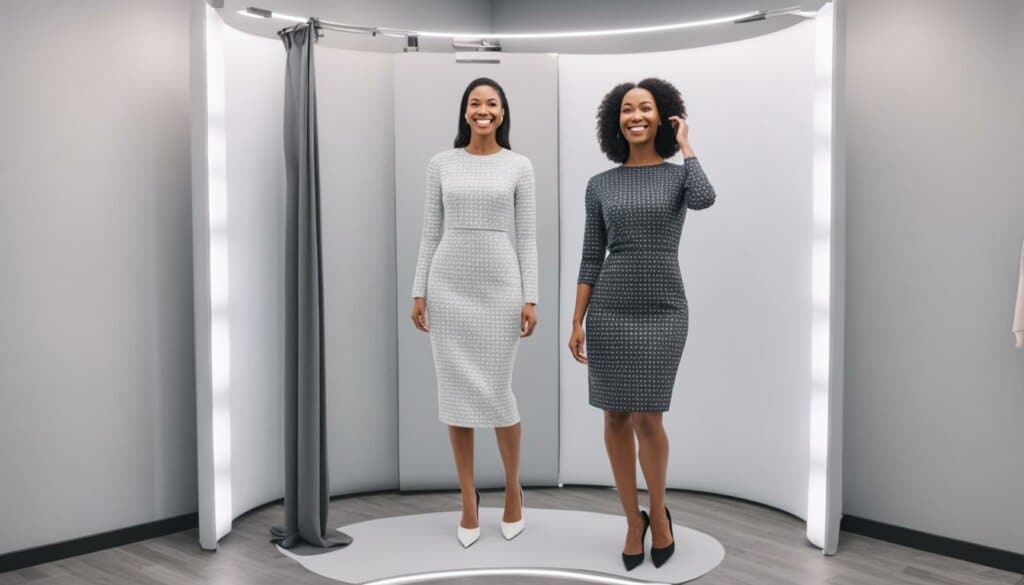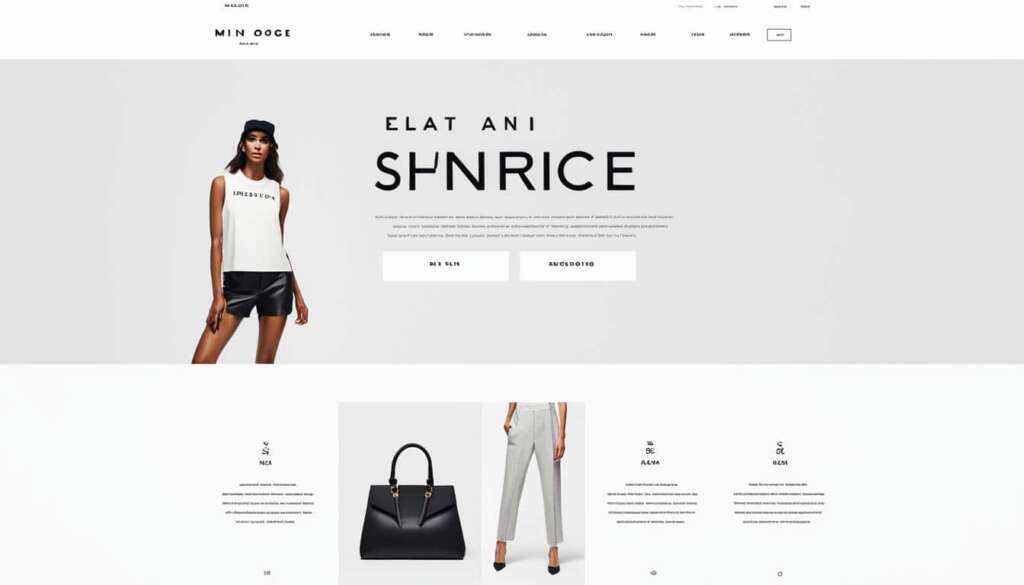Table of Contents
The fashion industry is a dynamic and ever-changing industry that is heavily influenced by consumer behavior, technology, and market conditions. The global e-commerce industry is expected to reach $16 trillion by 2027, with fashion brands accounting for a significant portion of online sales. Even during the pandemic, the fashion e-commerce industry saw growth through virtual fitting rooms and convenient delivery options. Apparel and accessories have led the way in the recovery of the retail industry, with a growth rate of 23.1%. This has paved the way for new trends in fashion e-commerce.
When it comes to fashion e-commerce, staying up to date with the latest trends is essential. Online retail has become the go-to platform for fashion brands to reach their target customers and drive e-commerce sales. From sustainable fashion to innovative technologies like virtual fitting rooms, fashion e-commerce is constantly evolving.
Insights into the Fashion E-Commerce Industry
The fashion e-commerce industry has experienced significant growth in recent years, thanks to the global online fashion market. Valued at a staggering $752.5 billion in 2020, the online fashion market is the largest segment of the B2C e-commerce market, indicating the growing popularity of fashion e-commerce.
In the United States alone, fashion e-commerce accounted for 29.5% of all fashion retail sales in 2020. With revenues expected to reach $153.6 billion by 2024, the fashion e-commerce industry continues to show promising prospects. This robust growth is attributed to the increasing prevalence of mobile shopping.
Mobile devices are driving the online fashion sales and traffic, contributing to 66% of online fashion sales and 76% of online traffic. As shoppers become more tech-savvy and embrace the convenience of mobile shopping, the fashion industry must adapt accordingly to meet their evolving needs.
One of the key strategies employed by fashion brands is the integration of omnichannel experiences. By providing a seamless shopping experience across multiple platforms, from desktop to mobile, fashion brands can cater to shoppers’ preferences and create a cohesive shopping journey.
Social media influencers also play a crucial role in the fashion e-commerce industry. With the rise of platforms like Instagram and blogs, social media influencers have become powerful advocates for fashion brands. Their influence and reach are valuable tools for fashion e-commerce businesses to engage with a large audience and drive sales.
“The fashion e-commerce industry is constantly evolving, driven by the global online fashion market, mobile shopping trends, and the influence of social media influencers.”
The Impact of Social Media Influencers
Social media influencers have revolutionized the way fashion brands connect with consumers. Their authentic content, personal style, and expertise in the fashion industry have made them trusted voices among their followers.
Through their social media platforms and blogs, influencers provide style inspiration, product recommendations, and fashion insights. Their endorsements and collaborations with fashion brands can significantly impact consumer behavior, driving sales and brand awareness.
By leveraging the power of social media influencers, fashion e-commerce businesses can tap into a wider audience and build brand loyalty. Collaborating with influencers allows brands to showcase their products in an authentic and relatable manner, increasing consumer trust and engagement.
Omnichannel Experiences in Fashion E-Commerce
Omnichannel experiences have become a necessity for fashion brands in the e-commerce space. To stay competitive, fashion brands need to offer a seamless shopping journey across various channels, including websites, mobile apps, and physical stores.
By integrating all these channels, fashion brands can provide a consistent experience to shoppers, regardless of the platform they choose. This allows customers to browse products, make purchases, and receive support effortlessly, enhancing their overall satisfaction and encouraging repeat business.
| Channel | Benefits |
|---|---|
| Websites | Convenient online shopping experience |
| Mobile Apps | Access on-the-go and personalized offers |
| Physical Stores | In-person try-ons and customer service |
Omnichannel experiences enable fashion e-commerce businesses to meet customer expectations and provide a holistic shopping experience that seamlessly combines the online and offline worlds.
In the next section, we will explore the top strategies for success in the fashion e-commerce industry. Stay tuned for valuable insights and practical tips to thrive in this competitive market.
Top Strategies for Success in Fashion E-Commerce
In the fast-paced world of fashion e-commerce, staying ahead of the competition requires implementing top strategies for success. Today’s consumers are increasingly conscious of sustainability and ethical sourcing, driving the need for fashion brands to adopt eco-friendly practices.
Sustainability – Delivering fashion that is environmentally friendly and socially responsible is essential for attracting and retaining customers. Slow fashion, which focuses on creating long-lasting, timeless pieces, is gaining popularity. Vegan leather and upcycled fashion, made from repurposed materials, are also on the rise.
Ethical Sourcing – Responsible sourcing practices, such as fair trade and transparency in the supply chain, are becoming more important to consumers. Brands that prioritize ethical sourcing cultivate trust and build strong relationships with their customers.
Re-commerce – The trend of re-commerce, where customers resell or rent clothes, is gaining momentum. This concept aligns with the growing interest in minimalism, reducing waste, and embracing a circular economy. By offering re-commerce options, fashion e-commerce platforms can capture the attention of environmentally conscious shoppers.
Virtual Fitting Rooms – Virtual fitting rooms have revolutionized the online shopping experience. By using augmented reality (AR) and virtual reality (VR) technology, customers can visualize how garments will look and fit before making a purchase. This reduces the need for returns and improves customer satisfaction.
Athleisure – Athleisure has emerged as a major trend in fashion. This style combines athletic clothing with leisurewear, providing comfort and versatility. The rise of athleisure presents an opportunity for fashion e-commerce brands to tap into this growing market segment.
Genderless Fashion – Genderless fashion, offering unisex options, is gaining traction and challenging traditional gender norms in the industry. By embracing gender-neutral designs, brands can appeal to a broader audience and promote inclusivity.
Buy Now Pay Later – Offering flexible payment options, such as buy now pay later, can attract budget-conscious shoppers and increase sales. This payment model allows customers to divide their purchases into installments, making fashion more accessible and affordable.
AI Recommendations – Leveraging artificial intelligence (AI) for personalized recommendations enhances the shopping experience. By analyzing customer data and shopping behavior, AI algorithms can suggest relevant products, improving conversion rates and customer satisfaction.
Key Strategies for Success in Fashion E-Commerce:
- Embrace sustainability and ethical sourcing practices
- Explore re-commerce options to tap into the circular economy
- Invest in virtual fitting room technology for enhanced customer experience
- Cater to the athleisure trend through versatile and comfortable designs
- Promote genderless fashion to foster inclusivity
- Offer flexible payment options like buy now pay later
- Utilize AI recommendations to personalize the shopping journey
By implementing these strategies, fashion e-commerce brands can attract and retain customers, drive sales, and position themselves for long-term success in the ever-evolving industry.

Creating a Fashion E-Commerce Business Plan
Starting a fashion e-commerce business requires careful planning and strategizing. A well-structured business plan is essential to lay the foundation for success in the competitive online retail market. This section will delve into the key aspects of creating a fashion e-commerce business plan, including the low barriers to entry, competition, business models, sourcing strategies, and the significance of having a mobile-friendly website.
Low Barriers to Entry and High Competition
One of the advantages of entering the fashion e-commerce market is the relatively low barriers to entry. With the availability of e-commerce platforms and tools, anyone can start their own online store. However, it is important to note that the fashion e-commerce industry is highly competitive. Established brands and new startups alike are vying for a share of the market, making it crucial to differentiate your brand and offer unique value to customers.
Defining Your Business Model and Target Customers
A well-defined business model is the foundation of a successful fashion e-commerce venture. Consider whether you want to focus on selling your own brand, curating products from different designers, or incorporating a mix of both. Understanding your target customers and their preferences will help tailor your offerings and marketing strategies accordingly.
Sourcing Strategies: Print on Demand (POD) and Cut and Sew
Sourcing products is a critical aspect of a fashion e-commerce business. Two popular options to consider are Print on Demand (POD) and cut and sew services. With POD, you can offer a wide range of custom-designed apparel and accessories without maintaining inventory. Cut and sew allows you to produce your own unique designs, giving you greater control over the manufacturing process. Your business plan should outline your sourcing strategy and associated costs.
The Importance of a Mobile-Friendly Website
In today’s digital age, having a mobile-friendly website is essential for any fashion e-commerce business. The majority of online shoppers use their mobile devices to browse and make purchases. A website that is optimized for mobile devices ensures a seamless and user-friendly experience, leading to higher conversion rates and customer satisfaction.
To create a successful fashion e-commerce business, it is imperative to develop a comprehensive business plan that covers all the essential elements. By understanding the low barriers to entry, the competitive landscape, and the importance of a well-defined business model, sourcing strategies, and a mobile-friendly website, you can set yourself up for success in the fashion e-commerce industry.
Conclusion
The fashion e-commerce industry continues to thrive and evolve, presenting both opportunities and challenges for fashion brands. Staying competitive in this dynamic landscape requires a keen understanding of the latest trends and the implementation of successful strategies.
Sustainability is a key trend driving the fashion e-commerce industry, with consumers increasingly seeking ethically sourced and eco-friendly products. Re-commerce, virtual fitting rooms, and athleisure are also gaining prominence, reflecting changing consumer preferences and lifestyles.
To succeed in fashion e-commerce, brands must consider important factors such as genderless fashion, offering inclusive options, and implementing innovative solutions like AI recommendations and buy now pay later options. These strategies enhance the online retail experience, attracting and retaining customers.
Additionally, fashion brands must develop a comprehensive business plan that outlines their vision, target market, and competitive advantage. With low barriers to entry and intense competition, a well-defined business model and a mobile-friendly website are instrumental in achieving success in the fashion e-commerce industry.
FAQ
What is the value of the global fashion e-commerce market?
The global online fashion market was valued at $752.5 billion in 2020.
What percentage of fashion retail sales in the United States is accounted for by e-commerce?
In 2020, fashion e-commerce accounted for 29.5% of all fashion retail sales in the United States.
What is the role of mobile devices in online fashion sales?
Mobile devices contribute to 66% of online fashion sales and drive 76% of online traffic.
How do fashion brands cater to shoppers on multiple platforms?
Fashion brands now offer omnichannel experiences to cater to shoppers on multiple platforms.
What role do social media influencers play in the fashion e-commerce industry?
Social media influencers play a significant role in the fashion e-commerce industry, with platforms like Instagram and blogs reaching a large audience.
What are the top strategies for success in the fashion e-commerce industry?
The top strategies for success in the fashion e-commerce industry include sustainability and ethical sourcing practices, re-commerce, virtual fitting rooms, athleisure, genderless fashion, buy now pay later options, and AI recommendations.
What should be included in a fashion e-commerce business plan?
When creating a fashion e-commerce business plan, it is important to outline the products or services, financial status, operations model, target customers, and considerations for sourcing products such as using Print on Demand (POD) or cut and sew services. Additionally, having a mobile-friendly website is essential.
How can fashion brands stay competitive in the online retail scene?
Fashion brands can stay competitive by staying informed about the latest trends and implementing effective strategies such as sustainability, re-commerce, virtual fitting rooms, athleisure, genderless fashion, buy now pay later options, and AI recommendations.







